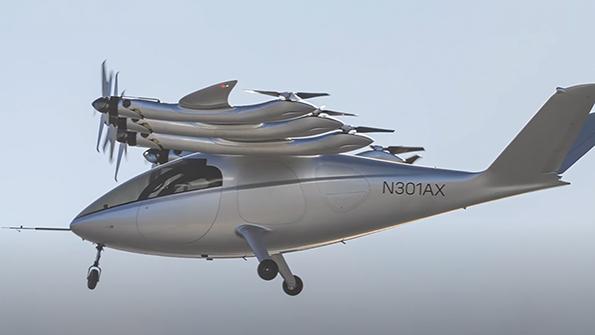Transition Between Vertical, Forward Flight A Key Milestone For eVTOL

Archer Aviation on Dec. 1 trumpeted the first full transition between vertical and wingborne flight by its Maker electric vertical-takeoff-and-landing demonstrator.
In September, Lilium made much of the fact that its Phoenix ducted-fan electric vertical-takeoff-and-landing (eVTOL) demonstrator had achieved full transition on both its main wing and canard foreplane.
Why is transition such a big deal for the eVTOL industry, not only for the startups developing the vehicles but also for the regulators setting the certification requirements for this new class of aircraft?
In May, the FAA surprised industry with a change of direction on eVTOL certification. Deciding to treat the vehicles as a special class of powered-lift aircraft, the FAA said it was developing new airworthiness criteria “because no existing standard captures the powered-lift’s transitional flight modes.”
The shift pivoted on concerns that pilots trained to fly fixed-wing general aviation aircraft certified under Part 23 rules might not have the skills required to fly an eVTOL safely through the transition between vertical and forward flight.
This is because the close interaction between aerodynamics and propulsion changes the way an eVTOL behaves and is controlled as the aircraft goes though its mode change from thrustborne to wingborne flight and back.
In a helicopter, air flows down through the rotor in hover. Lift on the blades provides both thrust and control. To fly forward, the rotor disk is tilted. But as speed increases, the rotor begins to fly edgewise. This is not aerodynamically efficient.
It’s a similar situation for a multicopter eVTOL such as Volocopter’s VoloCity. But instead of using rotor-blade pitch, such vehicles are flown drone-style by controlling the speed of the electric motors driving multiple fixed-pitch propellers to vary their thrust.
The speed and range of multicopters are limited, so most startups are developing winged eVTOLs. These spend only a short time in vertical flight, for takeoff and landing, and quickly transition to aerodynamically efficient wingborne flight for cruise, to extract the maximum speed and range from limited battery energy capacity.
Whether the transition is effected by tilting props, tilting wings or some other mechanism, flight control of such an eVTOL must transfer from the propulsion system to its aerodynamic controls as the vehicle converts between helicopter and airplane mode. Even with fly-by-wire, this is dynamically complex.
This is the crux of why achieving transition is such a big deal for eVTOL developers. Almost every vehicle is different and unproven—Archer’s “12-tilt-6” and Lilium’s ducted-fan vectored thrust are just two of the new configurations.
The only relevant powered-lift configuration with any significant experience is the decades-old tiltrotor. The Bell-Boeing V-22 has been in military service since 2007, but the first civil tiltrotor, Leonardo’s AW609, has yet to be certified by the FAA almost 20 years after its first flight. Powered lift is not easy.
Proving that an unconventional design with tightly integrated propulsion and aerodynamic control effects is feasible and safe is critical to convincing investors, regulators and customers.
But there is a nuance to the declarations of successfully demonstrating transition. Archer’s Maker and Lilium’s Phoenix are not full scale to their planned production aircraft. They are close, but there is a need to extrapolate, and in designing for vertical flight, scaling up is notoriously tricky.
Among eVTOL startups, surprisingly few have achieved full transition at full scale. Joby Aviation has, with two remotely piloted prototypes of its tiltprop S4. Beta Technologies, with its lift-plus-cruise Alia, has flown two full-scale piloted prototypes but not yet demonstrated transition.
Boeing-backed Wisk has transitioned its Cora prototypes, but its production eVTOL is a bigger aircraft with a different configuration. China’s AutoFlight has demonstrated multiple transitions with full-scale uncrewed demonstrators for its Prosperity eVTOL, building on experience with smaller cargo UAVs.
So Archer and Lilium have achieved milestones—two more configurations have been added to the list of VTOL concepts that have demonstrated transition—but there can be no relaxing for the advanced air mobility industry until full-size, type-conforming certification test aircraft are flying routinely.





